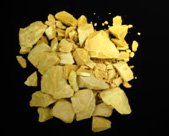Sulfur liver
| General | |||||||||||||
|---|---|---|---|---|---|---|---|---|---|---|---|---|---|
| Surname | Potassium polysulfide | ||||||||||||
| other names |
Sulfur liver |
||||||||||||
| Molecular formula | K 2 S x with x = 2 to 6 | ||||||||||||
| Brief description |
yellow-green to liver-brown solid with a smell of hydrogen sulfide |
||||||||||||
| External identifiers / databases | |||||||||||||
|
|||||||||||||
| Drug information | |||||||||||||
| ATC code | |||||||||||||
| properties | |||||||||||||
| Molar mass | Cannot be specified because of different composition | ||||||||||||
| Physical state |
firmly |
||||||||||||
| density |
1.65 g cm −3 |
||||||||||||
| Melting point |
200-250 ° C |
||||||||||||
| solubility |
good in water (500 g l −1 ) |
||||||||||||
| safety instructions | |||||||||||||
|
|||||||||||||
| As far as possible and customary, SI units are used. Unless otherwise noted, the data given apply to standard conditions . | |||||||||||||
Sulfur liver or Hepar sulfuris is an old name for a mixture of potassium sulfide , potassium polysulfide , potassium thiosulfate and potassium sulfate . It is obtained by melting together potassium carbonate (potash) and sulfur in the absence of air at 250 ° C.
The name goes back to the liver-brown color of the mixture.
properties
Aqueous solutions of sulfur liver slowly separate sulfur ( sulfur milk ) and gaseous, toxic hydrogen sulfide (H 2 S). This decomposition also takes place, albeit more slowly, if sulfur liver is not stored in the absence of air.
use
Sulfur liver is used medicinally (as a so-called: Kalium sulfuratum pro balneo ) for the production of sulfur baths for various skin diseases (especially fungal infections ). However, compared to the past, usage has decreased. The mixture is also used in various staining and dyeing processes. In the black and white photography , the finish is with a weak solution developed image stabilized and reddish brown toned .
In metalworking, sulfur liver was used to dye copper or silver black in ornaments and jewelry.
It is still used today to make copper pictures .
Historical
The Swedish chemist Carl Wilhelm Scheele used sulfur liver in his attempts to determine the composition of the air. In his manuscript Chemische Abhandlung von der Luft und dem Feuer , published in 1777, he concluded from an experiment with an aqueous solution of sulfuric liver that " the air must be composed of elastic liquids of two kinds ", one of which is fire air ( oxygen ).
The hepar sample , published for the first time in 1697, was given this name because this detection reaction creates a compound that is reminiscent of the liver of sulfur in color.
literature
- Werner Schröter et al .: Taschenbuch der Chemie , Verlag Harri Deutsch, Thun, 1988, p. 322 ISBN 3-87144-922-9
Individual evidence
- ↑ a b c d e f Entry on potassium polysulphides in the GESTIS substance database of the IFA , accessed on January 8, 2018(JavaScript required) .
- ↑ Entry on Potassium sulfide (K2 (Sx)) in the Classification and Labeling Inventory of the European Chemicals Agency (ECHA), accessed on February 1, 2016. Manufacturers or distributors can expand the harmonized classification and labeling .



